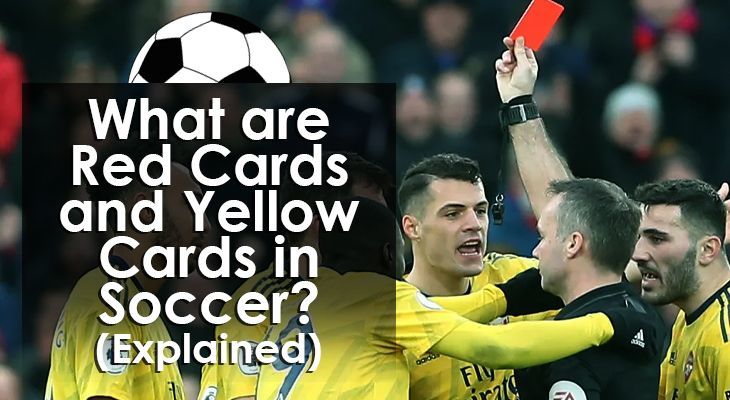What are Red Cards and Yellow Cards in Soccer? (Explained)
Tune in on any soccer match and you'll often see the referee brandish red or yellow cards above their head.
These cards are given to players who have committed a foul or some form of misconduct during the match.
The ref can hand these out for just about anything - from persistent fouling and faking an injury to diving, dissent and dangerous play.
Today we'll take a closer look at the difference between the two cards, where they came from, and what it means to receive them.
The Origins of Red and Yellow Cards
The practice of cautioning and sending off players has been part of the Laws of the Game since 1881.
Although the use of red and yellow cards have become a standard todays game, they were only first used during the 1970 World Cup in Mexico.
Ken Aston first came up with the idea of the colored cards after much confusion during the 1966 World Cup.
Tasked with overseeing all the referees, he noticed that there was a lot of confusion regarding foul calls, cautions, and send offs.
The referee's decision wasn't always clear to the players, coaches and fans.
This confusion was in large part due to the wide variety of languages used at the World Cup.
His idea of color-coding was first implemented at the subsequent 1970 World Cup.
Referees handed out yellow cards to caution players and red ones to dismiss them entirely from the game.
More than 50 years later, this color-coding system is still the standard used around the world.

When is a Yellow Card Handed Out?
The referee can decide to caution a player with a yellow card for a host of different infractions.
These include any of the following offenses:
1. Unsporting Behavior
This covers a lot of things from reckless fouls to deliberate fouls that stop a promising attack.
Diving and feigning injury as well as excessive goal celebrations (taking off your shirt, for instance) are included.
The list goes on but it is generally up to the referee and what he considers unsportsmanlike.
2. Dissent by Word or Action
Again, this depends on what the referee deems unnecessary or excessive.
Some of the usual examples are swearing and using insulting language.
Same goes for crowding around the referee, clapping sarcastically at a decision, and throwing the ball away.
3. Persistently Infringing on the Laws of the Game
Committing a small foul does not necessarily mean getting called for a yellow card.
However, the referee can opt to hand one out to players who continuously commit small fouls throughout the match.
4. Delaying the Restart of Play
Play stoppage happens a lot in soccer, whether it be due to a foul call, an injury, or a ball going out of bounds.
Referees hand out yellow cards to players who deliberately delay the restart of play.
These include players wasting excessive amounts of time during free-kicks and goal-kicks.
5. Fails to Respect the Required Distance
During free-kicks, corners, or throw ins, players must stand at least ten yards away.
If they don't retreat despite several warnings, they can be called for a yellow card.
6. Entering or Leaving the Pitch Without the Referee's Permission
This refers to a substitute entering the field of play before the referee allows the change.
This also includes players re-entering without permission (those who went off for injury reasons during the match).
In the same way, a player who leaves the field without the referee's consent is also handed out a yellow card.
7. VAR Rules
In leagues with VAR (Video Assistant Referees), players can also receive a yellow card for entering the referee's review area.
The same goes for excessively asking referees to review a decision with VAR.
If a player receives two (2) yellow cards during a match, then a red card is automatically given. That player must then leave the field of play immediately.
Players sent off via red cards can no longer re-enter the match. This puts their team at a disadvantage as they must continue the match with less players.

When are Players Given a Red Card?
As mentioned earlier, a red card means that a player is sent off and that they can no longer be part of the match.
Players given red cards cannot be replaced, leaving their team at a numerical disadvantage.
Take note that even players on the bench and managers themselves may receive red cards if they commit an offense that warrants a dismissal.
Players and managers alike may receive a red card for any of the following offenses:
1. Serious Foul Play
These are reckless fouls, usually done with excessive force, that can lead to injury.
Examples of such are two-footed tackles, slides coming from behind, and tackles that are too high.
Again, it is still up to the referee to determine whether the foul warrants a yellow or red card, or nothing at all – controversial!
2. Violent Conduct
Unlike Serious Foul Play, Violent Conduct can also be committed by players on the bench, as well as the coaching staff and managers.
This goes for any act regarded as violent by the referee. These include kicking, punching, elbowing, kneeing or attacking an opposing player or personnel.
3. Spitting and Abusive Language
While abusive language is usually punished with a yellow, spitting at an opponent or referee almost always results in a red card.
Offensive language, such as homophobic or racist remarks, should also result in a send off.
4. Denying an Obvious Goal-Scoring Opportunity with a Handball or Deliberate Foul
Red cards are given to players who intentionally foul an attacking opponent with a clear opportunity to score a goal.
The same goes for players who deliberately use their hands or arms to block a shot (aside from the goalkeeper, of course).
In addition a goalkeeper receives an automatic red card if they handle the ball outside of the box.
5. Receiving a Second Yellow Card
As previously mentioned, a player receiving a second yellow card during the same match equates to an automatic red card.
These are most of the ways a player is called for a yellow or red card.
But how does it affect the team?

The Consequences
In-game Consequences
When a player is given a yellow card during a match, they are still allowed to play on.
However, they need to practice more caution as a second one will result in an ejection.
A red card, on the other hand, results in automatic send off.
Once a player has been sent off, they are not allowed to return to the game nor stay in the team's technical area.
The player must leave the side of the pitch immediately.
The same is true for the team manage and members of the coaching staff.
If the goalkeeper gets sent off, then an outfield player must replace him -- provided they no longer have substitutions available.
The player dons the keeper's jersey and plays the rest of the match in goal.
Accumulated Yellow Cards and Sanctions
Consequences of these cards extend beyond a single game.
Suspensions may be given throughout the course of a season, depending on the amount of accumulated cards.
This rule, however, varies from league to league and tournament to tournament.
The Premier League, for instance, has its own rules regarding accumulated penalties:
- Players who earn five (5) yellows in their team's first nineteen (19) games have to serve a one-match ban.
- Players who accumulate ten (10) yellow cards by the 32nd are given a two-match ban.
- Particularly dirty players who receive fifteen (15) yellow cards by the 38th game are given a three-match ban.
- Twenty (20) yellow cards results in a hearing with the Regulatory Commission.
Cards (or bookings) from different tournaments, however, do not count to their season tally. This means that cards during tournaments like the EFL Cup or the FA Cup, for example, do not add to their Premier League total.
On the other hand, the UEFA Champions League has its own set of rules. Here, two (2) yellow cards at any stage of the tournament results in a one-game suspension.
Accumulated Red Cards and Sanctions
In the UEFA Champions League, players who receive red cards could possibly face further suspensions.
This is in addition to them missing the rest of the match and handing their team a clear disadvantage.
The duration of the suspension, however, depends on the seriousness of their offense:
- If, for instance, they were sent off due to two (2) yellow cards then they only miss one match.
- The same goes for deliberate fouls denying a clear goal-scoring opportunity. The same one-game suspension is given to the player sent off for this reason.
- For any form of dissent, a two-match ban is usually handed out.
- On the other hand, violent conduct can result in a three-match ban or more depending on the severity.
Each foul is reviewed by a panel to determine the seriousness of the violation and the corresponding suspension.
In general, teams can only receive up to four (4) red cards during a match.
Any more and the game is abandoned as they can no longer field the required minimum number of seven (7) players.
Conclusion
Though most players avoid bookings entirely, getting called for a yellow card can sometimes work to your advantage.
Some players give up the penalty to prevent the opposition from breaking away.
Knowing when to pick up a yellow card, however, is another thing entirely.
This comes with experience and game management – for now, just concentrate on avoiding them if you can!
Hopefully reading this article helps prevent needless bookings and suspensions.

